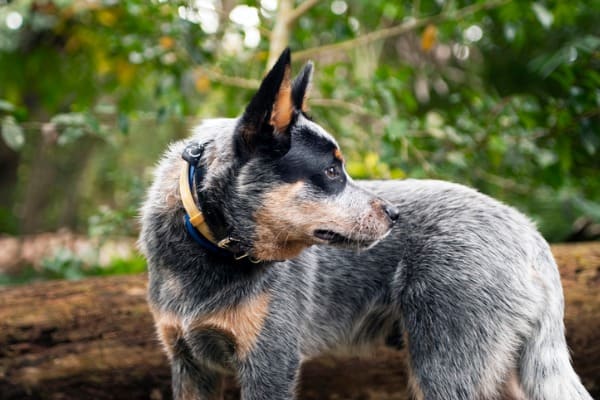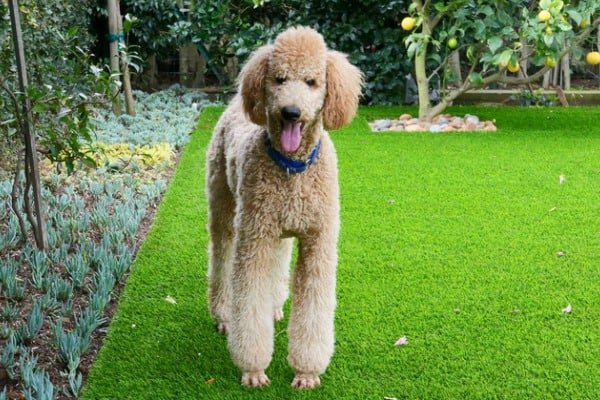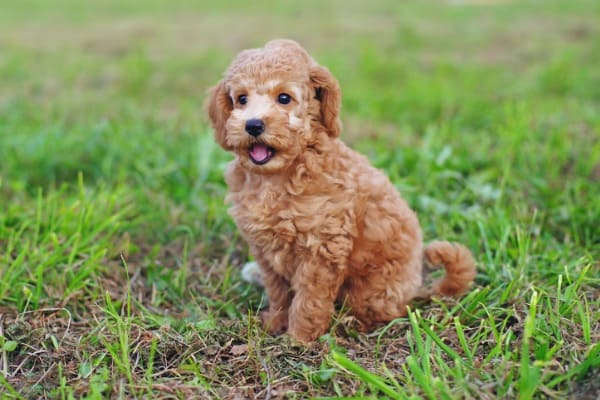Australian Cattle Dog, ACD, and Blue Heeler – several names for one dog breed.
Poodles can be Standard, Miniature, and Toy – all size variations on one distinct breed.

What about when their genetics combine to make a hybrid?
What exactly do you call that, and what are those dogs like?
You’ll probably hear them referred to as a Heeler Poodle mix more than anything.
How they will look, behave, and mesh with your lifestyle will depend on several factors.
No one knows for sure what kind of offspring two dogs will produce, and that’s true for purebreds as much as it is for hybrids.
Luckily, there are some things to look at that can help you get a better picture of how a Heeler Poodle mix will turn out.
A Look at Each Side of the Family
Getting to know the breed characteristics of both sides of a hybrid is helpful in understanding the many outcomes you can expect.
There’s no secret formula for a dog to inherit specific traits – it’s all about the genetic lottery.
So everything about each breed should be something you’re comfortable with since the hybrid can inherit just about anything.
Australian Cattle Dog

Here’s another name for them: The Queensland Heeler.
They get that name from Australia, where they originate. They even have some Dingo in their genes.
These tough dogs were bred to withstand the harsh terrain of the Australian bush, where they excel at herding livestock.
They’re extremely bright and are among the most capable herding dogs.
Harsh weather, large animals, and long working hours are no match for them.
Their strong will to work makes them active by nature – this is not a dog who will sit around in your lap all day.
Outside is their favorite place, but they can learn to live in the city or suburbs as long as they have access to some open spaces.
They’re referred to as Blue Heelers because of the distinctly blue hues in their coats.
They can have rust and black patches mingled with their bluish-gray fur, making for some beautiful patterns.
Their double-layer coat doesn’t grow too long, but it is thick, something that helps shield them from the elements.
You might think that thick fur makes them bad candidates for hot climates, but on the contrary, their undercoats can insulate them from high heat as well as cold.
Puppies will have “floppy” ears that will become naturally upright as they develop.
Their erect ears add to the alert and focused expression they seem to wear at all times.
ACDs don’t miss much and can make great alert dogs. They will sometimes bark at the sound of a doorbell or the sight of a stranger approaching the home.
Overall, they can be raised to be quite social dogs and generally make friends with humans and other pets.
They’re 35-50 lbs and quite stout. You won’t see any spindly Greyhound features here.
Their build is muscular, which helps in the agile and physically demanding work they were bred for.
A Blue Heeler mix of any kind can have a few health issues, which we’ll cover soon. However, with proper care, they can have a lifespan that reaches into the mid to late teens.
The oldest dog on record is an Australian Cattle Dog named Bluey. An Australian native, Bluey lived to a jaw-dropping 29 years of age.
Poodles
We’ll cover a few varieties of Poodle since it is possible to see each of them crossbred with a Blue Heeler.
Standard Poodle

They’re second on the list of smartest dogs, behind only the Border Collie.
Most Poodles carry the stereotype of being the fashion accessory of the canine world.
Aside from being highly intelligent, they can be formidable opponents in agility and obedience trials.
They are also powerful swimmers. It might come as a surprise to some, but they were originally bred in Germany, not France, as retriever dogs.
Take a look at a Poodle’s paws, and you’ll find the classic webbed toes, which are ideal for swimming.
That thick, curly fur coat isn’t just for show, either. Unlike many breeds, they have a single-layer coat, which still does a remarkable job protecting them from harsh environments.
Their hair can grow very long and take on a fluffy appearance, leading many Poodle parents to opt for professional grooming and stylish hair-dos.
That coat can be black, white, gray, blue, or apricot, to name a few. The coat is always solid colored.
Male Standard Poodles can reach up to 70 lbs, while females are slightly smaller at 50 lbs.
They’re tall – 15 inches or more – with long legs and slender builds.
Standard Poodles’ lifespans range from 10 to 18 years, which is on the higher end for such a large dog.
Miniature and Toy Poodles

The fur, coloring, and general build of Miniature and Toy Poodles are the same as Standards.
As the names imply, they’re the mini and toy versions of the Standard Poodle.
Miniatures usually don’t exceed 15 lbs, while toys are 4-6 lbs. Both are small enough that they won’t have the same exercise or space requirements as Standard Poodles.
They still like to be active and even compete in sporting events alongside their larger counterparts.
Miniatures and toys fall into the companion dog category. They might have a slightly different personalities than Standard Poodles.
They’re smart, loyal to their humans, and can have a bit of a territorial temperament if not properly curbed.
They can also be a little less outgoing and more content to stick close to their people.
Which One Goes Best With a Blue Heeler?
There is no right
or wrong answer to this question, as hybrids from all backgrounds, can make amazing pets.
The only caveat?
Toy Poodles might be too small to carry the offspring of an ACD. There’s no evidence that a toy breed and a medium-sized dog like the ACD can procreate naturally, such as with the ever-popular mini Goldendoodles.
Hybrids between two breeds similar in size are more common, and it’s safer for the dogs involved.
Temperament

So what does one smart dog plus another smart dog make?
Most likely, a very intelligent hybrid.
It’s these smarts that potential owners and seasoned pet parents alike will have to stay on top of.
An intelligent dog is one who is easy to train, eager to please, and responsive to learning new things.
It can also make them a little devious. ACDs, in particular, have been known to outsmart other dogs and people.
They’re not easily contained, so they need enough exercise to make them not want to take off on a leisurely run. Better yet, teach recalls from an early age.
Poodles are quite gentle and patient, while ACDs can be a little more excitable.
The herding instincts are strong with this one – a house with children or small animals might not be suitable.
ACDs have been known to attempt to herd children and other dogs by nipping at their heels.
For them, it’s just part of who they are, and it can be challenging to break them of this habit entirely.
Both breeds in this hybrid are social; they can thrive with many people and other dogs.
The trick is to properly socialize them so they’ll grow into laid-back pets.
They’ll likely be cooperative with training as long as they have an outlet for their energy.
Too much pent-up vitality will make them difficult to work with.
ACDs might be diggers if they feel too cooped up. They could try to tunnel an escape route under a fence, and they have the digging efficiency of a bulldozer.
They can also pull some surprising ninja moves on you – don’t be shocked if they try to go over a fence rather than under it.
Again, you can deter this with ample stimulation. If the dog doesn’t feel bored to tears in their own backyard, they’re less likely to look for something to do beyond the boundaries of the fence.
Those acrobatic-like moves they use to scale fences might be used in the house, too.
Blocking them off from a certain area with a baby gate might not be enough because they can easily scale it.
Indoors, the one reason they’ll escape from confinement is that they want to be close to you. Neither Poodles nor ACDs like to be alone very much.
They could develop separation anxiety if left on their own for long periods.
People who work long hours might consider a different hybrid for this reason alone.
Training
If you’re not prepared for an active lifestyle, this hybrid probably isn’t the one for you.
Each dog breed in the mix is energetic and will need daily exercise to be responsive to any training.
We’re not talking about a casual stroll around the neighborhood, either.
ACDs are one of the top recommended dogs for runners since it’s also one of their most favorite pastimes.
If you aren’t a runner, don’t cross this hybrid off your list just yet, though.
They can be exercised by playing fetch, hiking, playing with other dogs in the household, or even through agility training.
If they inherit any water-loving traits from the Poodle side, they’ll also enjoy swimming and playing in the water.
A small pool or sandbox in the backyard are good options for keeping them occupied.
Be willing to commit to daily walks – at least three hours of steady exercise per day.
You will need to get on your feet to exercise them even if you don’t run.
Once their exercise needs are met, they will be more than happy to learn obedience, basic manners, and even neat tricks.
A strong recall is a must-have for this breed since they might have the itch to take off or chase from time to time.
To avoid any territorial behaviors, socialize them early and often.
Some of them will have the urge to alert you – one that can be very difficult to train them out of if you don’t want it.
It is possible:
With some positive reinforcement and redirection, you can teach them not to go crazy when a guest comes over.
If their barking gets to be too much, talk to them in calm tones. Offer a toy to distract them.
Then, you can take the opportunity to show them that your guest is welcome in the home.
Most of these dogs will warm up to strangers quickly; they just need reassurance and a patient hand.
Good leash manners are something else we recommend teaching early on.
ACDs like to chase – sometimes it’s small animals, sometimes it’s a bag blowing in the wind.
Either way:
Teaching them to “heel” and not to pull is something you’ll be glad you worked on once they reach their full size.
We advise against retractable leashes. Stick to standard-sized ones that you have more control over.
A dog who has learned impeccable leash obedience can be given the privilege of a longer leash where it’s safe. As always, off-leash playtime is best in enclosed areas.
Want to impress your friends?
Take a look at how the intelligence of an ACD and good training can come together for some really cool commands.
This dog is ACD through and through. A hybrid that is half Poodle will have just as much, if not more, brainpower.
Care and Grooming
How to care for a dog with half of a Poodle’s coat and an ACD’s thick undercoat?
What do you feed them?
What toys should they have?
A lot will depend on their size and activity levels, but we’ll give you a general idea of what to expect.
Toys

A larger dog can destroy – and sometimes digest – plush toys. Both breeds in an ACD Poodle hybrid can be very enthusiastic when it comes to playtime.
Soft, squishy toys won’t last long. Toys that are specifically designed to be durable in the jaws of a larger dog are a wiser investment.
They will also enjoy heavy-duty chew toys and antlers. Avoid smaller, more fragile ones, which can be a choking hazard.
Rope toys or other tug toys might be a popular choice, especially if you have other dogs in the house who enjoy a good tug-of-war.
Just monitor playtime and keep a lookout for any aggression; dogs can sometimes get a little too attached to their toys and don’t always want to share.
These brainy pups can also get a lot out of puzzles or interactive dog toys.
Since they can bore quickly, it might be a good idea to keep these kinds of toys around for rainy days.
Diet
Again, their size will influence how much you feed your dog. High activity levels will also mean more food.
Any dog should be fed enough to replace the energy they burn, but not so much that they become obese.
Avoid cheap, carb-heavy dog foods, and opt for a more high-quality brand. Lots of protein is a must.
Treats are a powerful tool for training – just keep them small and dog-appropriate.
A slice of bacon for every good deed isn’t necessary.
Table scraps and people food should be kept away from them. Human food treats are for very special occasions – we’ve all given our dogs something tasty on their birthday.
Just avoid making a habit out of it, and your dog’s health will thank you. Stick to the best dog food for Australian Cattle dogs or check out dog food for poodles to compare.
Remember Bluey, the 29-year-old Blue Heeler we mentioned earlier?
He ate a lot of kangaroo and emu meat – although we can neither recommend this nor promise it contributed to his long life.
There is, however, some evidence that raw food diets can benefit dogs. It’s a conversation you can have with your vet if it’s an option you want to explore.
Grooming
If the hybrid has inherited the Poodle coat, they will need daily brushing to avoid any tangles or mats.
They might also need more frequent bathing and a monthly appointment with a groomer.
If their coat is long, you may decide you want to clip it shorter, especially in the summer months.
An ACDs coat is a little easier to care for, although they will still need frequent brushing.
As their undercoat sheds (once or twice a year), you will see them looking a little shabbier.
A decent shedding rake can help, and most dogs enjoy a good brushing.
Good news is if the hybrid has inherited the ACD coat.
The coat doesn’t get greasy or smelly, as is seen in some breeds.
So while they might get a little dirty from time to time, they’re not typically stinky.
Unless they roll in something foul – which is a risk for any dog breed out there.
Health

Poodles and ACDs carry risks for hip dysplasia. Toy and Miniature Poodles can also have some knee and elbow joint disorders.
ACDs might have hearing issues that can cause deafness, and some are born deaf.
Each of these is manageable, but they’re important to take into consideration before you commit to a hybrid of these breeds – health issues can be passed down from either side.
On the plus side?
Both breeds in the hybrid have life spans on the longer side, so a Blue Heeler Poodle mix should live a long and full life if their health is looked after.
Ready to Adopt?
So you’re active, have plenty of time to train a highly astute canine, and want a great companion?
If you’ve fallen in love with this hybrid, they might not be as readily available as other hybrids out there.
Blue Heeler Poodle mix puppies aren’t quite as common as other Heeler mixes.
They’re not impossible to find, especially if you’re open to scouting out shelters and rescue organizations.
Adoption fees through shelters will probably be less than buying a puppy.
If you’re going to pay up for a pup, make sure they come with a certificate of health.
Responsible breeders will screen both parents for the disorders we listed above, decreasing the odds that puppies will inherit anything serious.
A good breeder will also watch out for behavioral issues and temperament and avoid breeding any dogs who have undesirable psychological traits.
Do your homework before you buy one, and you can avoid any unwanted surprises.
If you rescue?
There’s always that chance the puppy or dog came from a backyard breeder or puppy mill. Or worse, was in an abusive home.
You’ll want to make sure you’re dedicated to any problems that can arise as a result.
Mistreated dogs sometimes require professional behaviorists or trainers to rehabilitate them.
Understand these possibilities and be ready to spend some resources on getting your rescue the help he needs.
It can be a long, difficult road, but crossing the finish line is one of the most rewarding things the parent of a rescue can experience.
Blue Heelers and Poodles: A Recipe for Smarts
Having a sharp dog comes with its ups and downs, but sometimes it just what you’re looking for.
A dog that loves sharing your favorite outdoor pastimes with you? Even better.
No one can promise you for sure what a hybrid dog – or any dog, for that matter – will be like.
At least you know that with this dog, proper training and exercise are the two best investments you can make to get a fun-loving and entertaining friend out of the deal.
Whether they take after the Poodle, the Blue Heeler, or something right down the middle, you’ll have a uniquely beautiful dog in your home.
Heeler Poodle mix dogs are sure to turn heads and impress with more than just their looks, too.
Above all else, they’ll be a great companion who will love to do just about everything with you.
